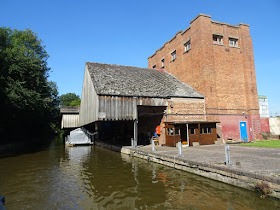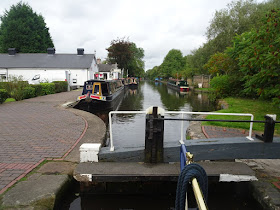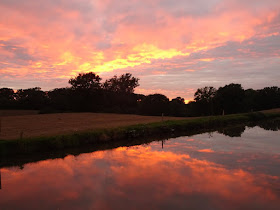This posting covers the last of the delightful Shropshire Union Locks and our travels along the rest of the Canal to Autherley Junction where it meets the Staffordshire and Worcestershire Canal. So we start with Tyrley Locks, the 5 locks coming out of Market Drayton heading south.
 |
| Below the first of the Tyrley Locks is a rock cutting that makes you wonder why the final lock wasn't put in a little further north to keep the canal closer to the natural lie of the land. |
 |
| Having gone up two locks, the third took us out of the rock cutting into the sunshine as we climbed the middle lock. |
 |
| Here we are coming up to the top lock. |
 |
| The buildings around the top lock create a classic and widely recognised canal view. We have four little pictures in the saloon on Leo of well known canal views and one is of Tyrley Top Lock. |
 |
| This little boat seen moored above the Tyrley Locks must be a contender for the smallest narrowboat on the canals! |
 |
| Above the Tyrley Locks is one of the deep and narrow cuttings that the Shroppie is famous for. This one is Woodseaves Cutting. It must have taken a lot of picks and shovels to dig it out. |
 |
| A few miles after the cutting is this factory which used from 1911 to 1961 to produce chocolate 'crumb' using local milk which was then transported by canal boat to Cadbury's factory at Bourneville just to the south of Birmingham. |
 |
| Beyond the factory is the Shebdon Embankment where we moored for the night on Friday (20th September). On Saturday we came off the embankment into Grubb Street Cutting where this bridge (called High Bridge) forms probably the most recognised view of the Shroppie. You will see that there is a horizontal strut in the bridge arch and on top is a mini telegraph pole. It no longer carries wires but it is such a well known sight that it is preserved. |
 |
| On Saturday we stopped at Norbury Wharf shown here for diesel. At 76p a litre it is one of the cheapest places on the system to fill up and one of the prettiest! Beyond the two boats moored on the left is a towpath bridge over an arm now used for boat repairing. This used to be the Newport Branch heading towards, you've guessed it, Newport. |
 |
| Gnosall is a pretty village a couple of miles south of Norbury Junction and then the canal goes through its only tunnel at Cowley. It is very short at 81 yards but the tunnel and the cutting either side is cut through solid rock. It was designed to be 690 yards long but the rock was so unstable that the tunnel was opened out as a cutting for much of its length. |
 |
| We moored on Saturday out in the countryside and, after a couple of hours servicing the engine, we walked into Church Eaton which proved to be yet another delightful place. |
 |
| On Sunday and with a change in the weather, we went into Brewood crossing the Stretton Aqueduct shown here. It crosses the A5 and represents one Telford transport project crossing another. |
 |
| Isn't it wonderful how those Victorian architects embellished their creations? The carved columns on the aqueduct really add to its appearance. |
 |
| Here is a view looking down to the A5. Not much traffic as this section is by-passed by the M54 as far as Telford. |
 |
| The canal passes through Brewood (pronounced 'Brood') in a deep cutting. We climbed up steps out of the cutting to do some shopping and to visit the Bridge Inn for Sunday lunch. Our timing for lunch was perfect as it rained fairly hard while we ate and then stopped to let us explore the village. As we don't like mooring in gloomy cuttings we carried on out of the village after lunch passing this view across fields to Brewood Church. |
 |
| We moored a couple of miles south of Brewood where our zoom lens could pick up the blocks of flats in Wolverhampton. We've been noticing Midlands accents for the last couple of days so we can now say that we are no longer in the north. |
 |
| On Monday we came down the last 3 miles of the Shroppie to Autherley Junction. The Staffs and Worcs Canal is just beyond the bridge and we turned left heading towards Great Haywood. Leo is sitting in the stop lock just before the junction. This lock raises the level only a few inches and seems pretty pointless until you understand the need for the Staffs and Worcs Canal not to lose all its water down the 'new' Shropshire Union Canal, hence the expression 'stop lock'. |
 |
| Here's the view looking back along the Shroppie past a boatyard where the Napton hire boats belong. |
 |
| This is the sign at the junction. We have come from the direction of Chester and we are now bound for Great Haywood. Stourport is where the canal meets the River Severn. |
 |
| Here, looking back, is the shapely bridge over the start of the Shroppie. |
Oddly having come south along the Shroppie our way is now north along the Staffs and Worcs. But canals seldom lend themselves to direct journeys. We could go via Birmingham but we have decided to avoid that and all the extra locks. Until you've been through Birmingham on a canal boat you don't realise that it is on top of a hill.
So what did we think of the Shropshire Union Canal? Lots of people seem to love the Shroppie but it is really not one of our favourites. We like canals that meander across the countryside whereas the Shroppie goes in pretty straight lines making use of huge embankments and deep cuttings to achieve this. The Shroppie was built much later than most of the other canals and it is more similar to a modern motorway. It might be a good idea for the speedy carriage of goods but that is not what attracts us to the canals. When we are on top of a big embankment or down in a gloomy cutting (one of our pet hates) we feel separated from the countryside and the rest of the world rather than part of it. Having said that, the flights of locks are a delight.





































































